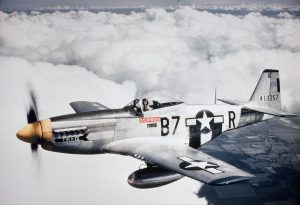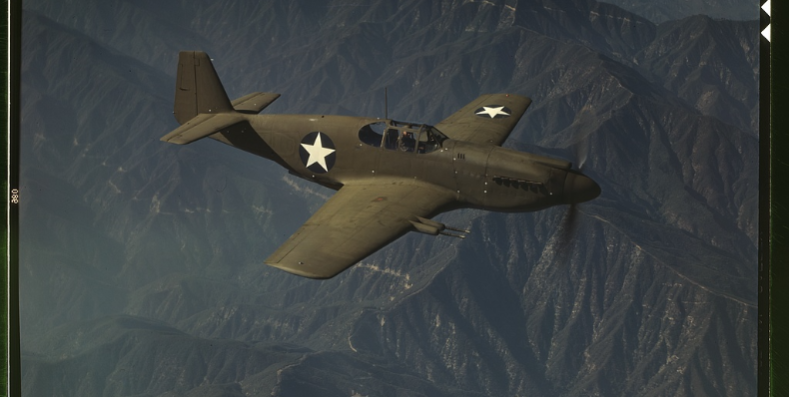Aviation Archives: P-51 Mustang
Contributor: Riley Yelverton
Sources: National Museum of The United States Air Force, The National WWII Museum
The P-51 Mustang is often hailed as the best fighter of World War II due to its remarkable blend of speed, range, maneuverability, and firepower. Its versatility allowed it to excel in various roles across all major theaters of the war, including long-range high-altitude escort, strafing, and photo reconnaissance. Initially developed by North American Aviation (NAA) for the British, the Mustang was subsequently ordered in large quantities by the U.S. Army Air Forces.
The Mustang’s design began in April 1940, led by James Kindelberger of NAA, in response to a requirement from the British Purchasing Commission. The Commission had approached NAA to produce Curtiss P-40 fighters for the Royal Air Force (RAF).

P-51 “Mustang” in flight, Inglewood, California. Courtesy of Library of Congress
The initial Mustang model featured the Allison V-1710 engine, which had limited high-altitude performance. The RAF was the first to use the Mustang operationally as a tactical-reconnaissance aircraft and fighter-bomber, known as the Mustang Mk I. The replacement of the Allison engine with a Rolls-Royce Merlin led to the P-51B/C (Mustang Mk III) models, significantly enhancing the aircraft’s high-altitude performance without sacrificing range. The definitive version, the P-51D, was powered by the Packard V-1650-7, a licensed version of the Merlin 66 with a two-speed, two-stage supercharger.
From late 1943, P-51Bs and P-51Cs, supplemented by P-51Ds from mid-1944, were used by the USAAF’s Eighth Air Force to escort bombers on raids over Germany. The RAF’s Second Tactical Air Force and the USAAF’s Ninth Air Force employed the Merlin-powered Mustangs as fighter-bombers, ensuring Allied air superiority in 1944. Mustangs were also deployed by Allied air forces in North Africa, the Mediterranean, Italy, and the Pacific. Mustang pilots claimed to have destroyed 4,950 enemy aircraft during World War II.
At the onset of the Korean War, the Mustang, re-designated as the F-51, served as a specialized fighter-bomber. Despite the emergence of jet fighters, the Mustang remained in service with several air forces until the early 1980s.

P-51D-5NA Mustang 44-13357. Courtesy USAAF







